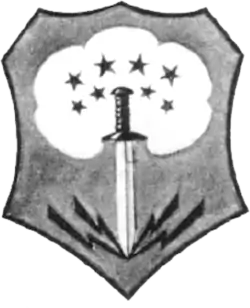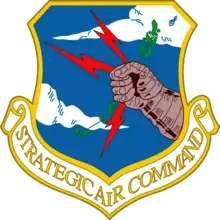422d Bombardment Squadron
The 422d Bombardment Squadron is an inactive United States Air Force unit. Its last assignment was as part of the 305th Bombardment Wing, stationed at Bunker Hill Air Force Base, Indiana.
| 422d Bombardment Squadron | |
|---|---|
 Emblem of the 422d Bombardment Squadron | |
| Active | 1942–1946; 1952–1954; 1958–1961 |
| Country | United States |
| Branch | United States Air Force |
| Type | Bombardment |

It was inactivated on 15 February 1961.
History
World War II
Established in June 1942 as a B-17 Flying Fortress heavy bombardment squadron; it trained under the Second Air Force. The squadron deployed to the European Theater of Operations in September 1942, being assigned to VIII Bomber Command in England. It began flying long-range strategic bombardment missions on 17 November 1942 and attacked such targets as submarine pens, docks, harbours, shipyards, motor works and marshalling yards in France, Germany and the Low Countries. Starting in 1943, the squadron began flying Nickling missions, dropping leaflets over occupied territory. In june 1944 this mission, along with most of the squadron's personnel and aircraft, were transferred to the 858th Bombardment Squadron and the 422d returned to strategic bombing operations.[1][2]
It continued attacks on enemy cities, manufacturing centers, transportation links and other targets until the German capitulation in May 1945.
After combat missions ended, the squadron moved to St Trond Air Base in Belgium in July 1945, where it conducted photo-mapping and intelligence-gathering flights over Europe and North Africa which came under the name Project 'Casey Jones'. On 15 December 1945 it moved to Lechfeld airfield, Germany which it had bombed on 18 March 1944 and which it now used as an occupation base.
The 364th Bomb Squadron was inactivated in December 1946 in Germany.
Tactical bomber training
During the Korean War, Tactical Air Command (TAC) trained aircrews at Langley AFB, Virginia. The three squadrons of the 4400th Combat Crew Training Group performing this mission were Air National Guard units that had been called up for the war. At the start of 1953, these squadrons were released to state control and the 423d Bombardment Squadron took over the mission, personnel, and equipment of the 115th Bombardment Squadron, which returned to the California guard.[3] It was then equipped with obsolete B-45 Tornado light bombers. The squadron was inactivated in 1954.
Strategic Air Command
From 1958, the Boeing B-47 Stratojet wings of Strategic Air Command (SAC) began to assume an alert posture at their home bases, reducing the amount of time spent on alert at overseas bases. The SAC alert cycle divided itself into four parts: planning, flying, alert and rest to meet General Thomas S. Power's initial goal of maintaining one third of SAC’s planes on fifteen minute ground alert, fully fueled and ready for combat to reduce vulnerability to a Soviet missile strike.[4] To implement this new system B-47 wings reorganized from three to four squadrons.[4][5] The 422d was activated at MacDill Air Force Base as the fourth squadron of the 305th Bombardment Wing. In June of that year, the unit moved to Bunker Hill Air Force Base, Indiana. As the 305th Wing transitioned to the Convair B-58 Hustler, the squadron was inactivated in February 1961.
Lineage
- Constituted the 33d Reconnaissance Squadron (Heavy) on 28 January 1942.
- Activated on 1 March 1942
- Redesignated the 422d Bombardment Squadron (Heavy) on 22 April 1942
- Inactivated on 25 December 1946
- Redesignated the 422d Bombardment Squadron (Light) on 15 November 1952
- Activated on 1 January 1953
- Inactivated on 23 March 1954
- Redesignated the 422d Bombardment Squadron (Medium) on 6 October 1958
- Activated on 1 January 1959
- Discontinued, and inactivated, on 15 February 1961
Assignments
- 305th Bombardment Group, 1 March 1942 – 25 December 1946
- 4430th Air Base Wing, 1 January 1953
- Tactical Air Command
- Attached to: 405th Fighter-Bomber Wing, 1 May 1953
- Attached to: 47th Bombardment Wing, 20 December 1953
- 47th Bombardment Group, 8 Feb-23 Mar 1954
- 305th Bombardment Wing, 1 January 1959
- 3958th Operational Evaluation and Training Group, 1 October 1959
- 305th Bombardment Wing, 8 March 1960 – 15 February 1961
Stations
|
|
Aircraft
- B-17 Flying Fortress, 1942–1946
- B-26 Invader, 1953
- B-45 Tornado, 1953–1954
References
Notes
- Maurer, pp. 517–518, 784–785
- Freeman, p. 263
- See Mueller, p. 315
- Schake, p. 220 (note 43)
- "Abstract (Unclassified), History of the Strategic Bomber since 1945 (Top Secret, downgraded to Secret)". Air Force History Index. 1 April 1975. Retrieved 4 March 2014.
Bibliography
![]() This article incorporates public domain material from the Air Force Historical Research Agency website http://www.afhra.af.mil/.
This article incorporates public domain material from the Air Force Historical Research Agency website http://www.afhra.af.mil/.
- Anderson, Capt. Barry (1985). Army Air Forces Stations: A Guide to the Stations Where U.S. Army Air Forces Personnel Served in the United Kingdom During World War II (PDF). Maxwell AFB, AL yes: Research Division, USAF Historical Research Center. Archived from the original (PDF) on 23 January 2016. Retrieved 28 June 2017.
- Freeman, Roger A. (1970). The Mighty Eighth: Units, Men and Machines (A History of the US 8th Army Air Force). London, England, UK: Macdonald and Company. ISBN 978-0-87938-638-2.
- Maurer, Maurer, ed. (1982) [1969]. Combat Squadrons of the Air Force, World War II (PDF) (reprint ed.). Washington, DC: Office of Air Force History. ISBN 0-405-12194-6. LCCN 70605402. OCLC 72556.
Mueller, Robert (1989). Air Force Bases, Vol. I, Active Air Force Bases Within the United States of America on 17 September 1982 (PDF). Washington, DC: Office of Air Force History. p. 315. ISBN 0-912799-53-6.
- Schake, Col Kurt W. (1998). Strategic Frontier: American Bomber Bases Overseas, 1950–1960 (PDF). Trondheim, Norway: Norwegian University of Science and Technology. ISBN 978-8277650241. Retrieved 27 July 2015.
Further reading
- Warren, Maj Harris G. (June 1947). "Special Operations: AAF Aid to European Resistance Movements 1943-1945, USAF Historical Study No. 121 (formerly AAF Reference History No. 21)" (PDF). Army Air Force Historical Office. Retrieved 29 October 2018.
